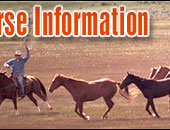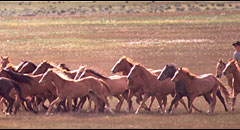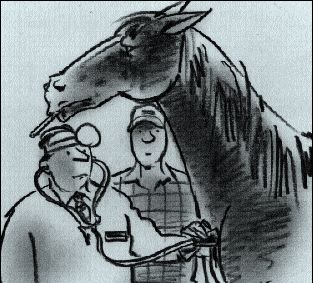 |
   |
|
|
|
You are here: Horses > Horse diseases > Strangles Cellulitis |
Horse Strangles Disease — What It Is, and How To Treat It
Strangles is a highly contagious disease that affects a
horse’s lymph nodes in its upper respiratory tract. It is
caused by a bacterium called streptococcus equi. The name,
strangles, was coined due to the strangling breathing sounds
made by affected horses, caused by the enlarged lymph nodes
of the jawbone. |
|
|
The first signs of strangles are a high fever, poor
appetite, and depression. Owners will also notice a thin,
watery discharge from the horse’s nostrils. This discharge
quickly turns thick and yellow. The horse’s upper
respiratory lymph nodes become enlarged, most noticeably the
ones between the jawbones. These can even abscess. Strangles is not usually fatal to horses, but it can be. |
Strangles can affect horses of any age, but most commonly
infects those between one and five years of age. The disease
is usually acquired after exposure to another horse that is
shedding the streptococcus equi bacteria, either during or
after its own bout of the illness. This commonly occurs when
new horses are introduced to an established herd. Although
the infectious horse may no longer show signs of strangles,
it can still spread the bacteria. Around twenty percent of
horses remain contagious for a month after all symptoms
vanish.
 While direct contact between horses is the most common way
that strangles is spread, it can also be spread by
contaminated equipment. Improperly cleaned and shared
buckets, stalls, and tack can spread the disease between
horses. Fortunately, the bacteria die fairly quickly in the
environment. While direct contact between horses is the most common way
that strangles is spread, it can also be spread by
contaminated equipment. Improperly cleaned and shared
buckets, stalls, and tack can spread the disease between
horses. Fortunately, the bacteria die fairly quickly in the
environment.
Once a horse is exposed to the bacteria, it will begin to
show symptoms in two to six days. If left untreated, it will
develop abscessed lymph nodes within one to two weeks after
the onset of illness. These lymph nodes will rupture and
drain, and the drainage is highly contagious. Most horses
will recover, but around ten percent of untreated horses
die, usually from a secondary infection which causes
pneumonia.
Rarely, the abscesses will spread to other parts of the
horse’s body, such as the lungs, internal organs, or even
the horse’s brain. This condition is called “bastard
strangles.” It is uncommon and is usually fatal.
The treatment of strangles is dependent on the stage of the
disease.
To control the spread of the strangles bacteria, any new
horse with a vague or unknown health history should be
isolated for four to six weeks before being added to the
general population of the stable or paddock. Nasal swabs can
ascertain whether the horse is shedding the streptococcus
equi bacteria, but because affected horses shed the bacteria
sporadically, one swab test is not enough. Three nasal swabs
over a period of seven days are required before it can be
assumed that the horse is negative for strangles.
Strangles can also be controlled by vaccinations. Although
modern vaccines are more effective than those of the past,
providing better protection with fewer side effects, they
are not a complete guarantee against the disease. Still,
vaccinated horses tend to have a less severe illness if they
do contract strangles. Horses cannot contract strangles from
the vaccine itself, since it is made from only parts of the
pulverized bacterium.
If you suspect that your horse has strangles, notify your
veterinarian to confirm the presence of the disease. The
sooner a positive diagnosis is reached, the less “down time”
the stable will have to tolerate. Also, if a horse begins
antibiotic treatment in the early stages of the disease,
lymph node abscesses can be prevented.
Old veterinary practices warned against using antibiotics
for strangles because of the suspicion that it could cause
bastard strangles. However, there is no evidence that this
is the case. Usually, when horses are treated with
antibiotics in the early stages of strangles, they will
recover unless the antibiotics are not given in the correct
amounts or are stopped too soon. Even if the horse is on
antibiotic therapy, it must be isolated from the rest of the
stable and herd to prevent the spread of the illness.
However, once lymph nodes have enlarged and become
abscessed, antibiotic treatment will only prolong the
horse’s illness. It is better to allow the abscess to open,
or have the veterinarian lance it, so that it may drain. The
best treatment at this point is to flush the drainage site,
keep the area as clean as possible, and to maintain strict
isolation of the ill horse.
If your horse was stabled near one who had strangles at a
show or rodeo, it is reasonable to treat it with antibiotics
for at least six days after exposure. This is because horses
usually don’t show the first signs of the disease for two to
six days. However, if your horse is kept in a barn where
other horses have strangles, antibiotics will do little to
prevent it from getting the disease.
 |
Read the next horse diseases article on Vaccinations for Your Horse. |
|
|
|
|
 |
|
|
|
|
|
Horse Education
|
|
|
|
|
Horse Information Topics
|
|
|
|
|
|
|
|
Horse Business Owners
|
| |
Advertise with Us
Have your horse products or services exposed to over 27,000 of our monthly visitors.
|
|
|
|
|
|